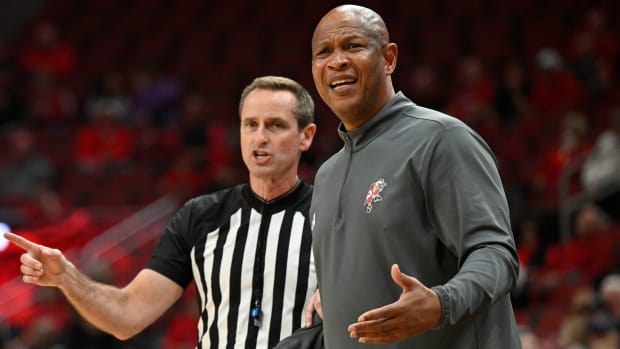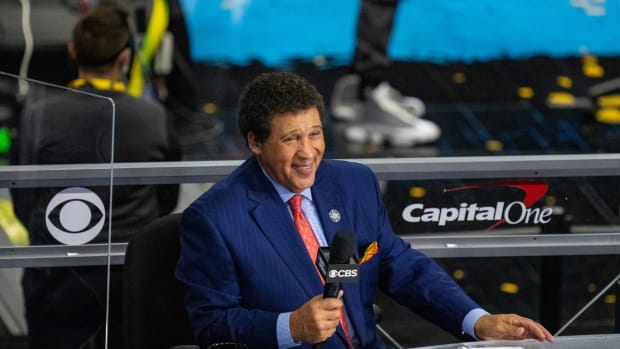ACC’s Growing Revenue Gap Sparks Frank Discussions Between Schools
AMELIA ISLAND, Fla. — For most of the first two days of the ACC’s spring meetings, the vacuum of information surrounding the future of the league’s revenue model has been filled with the common hysterics on social media about college sports being on the precipice of another summer of imminent realignment chaos.
Well, we might not be there—at least not yet.
Athletic directors were expected to only briefly discuss changing the ACC revenue distribution model this week, but those discussions expanded and intensified after the publication Monday of an SI story detailing some internal strife within the league over the growing revenue gap between the ACC and Big Ten/SEC. The first day of meetings instead went nearly 70 minutes over time and when finished, administrators and commissioner Jim Phillips hurriedly left the room and walked past reporters with heads down and little in the way of comment beyond a quip about needing to get to dinner, an agreement they made before breaking for the day, according to a source.
Florida State athletic director Micheal Alford who, along with Clemson’s Graham Neff, have been the most vocal in the need to change the revenue system, was complimentary about the behind-closed-door talks after Day 2. But it’s not expected that the athletic directors will vote on a proposal before they leave Florida, though substantial progress has been made toward a solution.
“These conversations that we’ve had in the last two days have been the most open and transparent discussions that we’ve had since I’ve been in this conference,” Alford said. “Now, I haven’t been in the conference very long, but talking to others who have been here for many years, they’ve commented that as well. They’ve never had this open transparent discussion amongst the ADs and the commissioner and the commissioner and his staff. The dialogue’s been great. People understand the issues, they’re really taking a look at how we’re gonna fix this model that we have in the ACC that would allow us to compete amongst our peers.”
Over the last several months, seven conference members coalesced over the situation, their officials meeting together and examining options to potentially exit or dissolve the league and break the grant of rights—a movement detailed in Monday’s SI story. Inside meetings this week, administrators acknowledged the situation with the seven, and the issue was discussed among officials, many of whom were not aware of the movement of their seven fellow members. Those seven schools—Clemson, Florida State, North Carolina, Miami, North Carolina State, Virginia and Virginia Tech—are not expected to continue any group meetings or pursue a group exit.
“We’re very thrilled about being in this league and we want to stay in it,” Alford said of his school’s outlook on the future.

Florida State athletic director Michael Alford struck an optimistic tone Tuesday on the ACC’s outlook after Sports Illustrated reported seven schools had discussed leaving the conference.
Alicia Devine/USA Today Network
As SI reported Monday, there were few solutions for the seven schools that did not involve significant legal battles from fellow members, the league office and ESPN, whose TV contract with the league coincides with the grant of rights. How much revenue a new model would pay ACC schools cannot bridge the sizable gap between the league and its competition in the SEC and Big Ten under the current agreement. While $5 million or $10 million extra certainly is not immaterial, it also isn’t the $30 million or $40 million an ACC school would need for complete monetary parity, a reality Alford acknowledges.
“There’s not a magic number,” Alford said. “Really, we’re looking to make sure we’re competitive. You look at the revenue shares of other leagues and how they’re gonna invest it and you need to be able to stay up to par with some of the changes they’re gonna do and how they’re gonna use that revenue. We’re the third-best media agreement right now, we want to stay the third-best. We've been able to compete with them being the third-best.”
To truly close the gap, the nuclear option of legally challenging the grant of rights and exiting the league is the only option. Many believe the grant of rights is airtight, and time will tell if it truly is. There are also many within college sports who believe a challenge to it is inevitable. But if doing so was straightforward or cheap, it would have happened already.
“There’s not an easy solution,” says Landis Barber, an attorney at the Raleigh-based Safran Law who has analyzed the grant-of-rights agreement. “You could see that if the league is dissolved, then there is no grant-of-rights agreements. But is this a viable option? Does it really get rid of your [TV] rights? A big issue is, what is ESPN’s incentive to let you out of this?”
Any new revenue model the athletic directors settle on would have to also be approved by the conference’s board of directors, composed of the 15 presidents and chancellors of ACC schools including Notre Dame (which competes in the conference for all sports except football and ice hockey). It would take the form of a merit-based payout system Alford referred to as “success initiatives,” and it is highly unlikely any of the payout would come from the TV revenue the league earns from ESPN, creating a base for every school. Instead, whatever new model is decided on would likely pay out from the pool including NCAA basketball tournament, bowl, expanded College Football Playoff and other money the league takes in. Wake Forest head coach Dave Clawson, whose school is not part of the seven that has brought this issue to the forefront, actually welcomed a system that rewards some sort of sporting merit.
“If revenue distribution is based on investment in football and on-the-field success, I think that’d be great and I think Wake Forest would be very comfortable with that model,” Clawson said. “If you base it on your investment in football and winning football games, I think we’d probably end up on the good end of that. Control the controllables. We have made a huge institutional investment in football at Wake Forest. We’ve invested over $110 million in new facilities over the last seven years. We’re about to open up a brand new $40 million locker room. We’ve won the second- or third- or fourth-most games in the ACC the last seven years, we have the second-longest bowl streak in the ACC.”
Don’t expect this to be the only tweak the schools make to the revenue agreement when it happens. It will be a big change, but Alford said the league will continue to find ways to pursue other revenue streams and generate more dollars in the future.




















